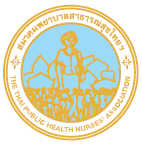Components of Health Literacy in Elderly Clubs, Metropolitan Bangkok
Keywords:
Component, Health literacy, Elderly clubAbstract
The identification of components of health literacy in elderly clubs in Bangkok will enhance elderly members’ potential for self-care through the 4 Smart (Walk Brain Sleep Eat) program. This quantitative research will analyze health literacy components of present elderly clubs. The sample is 221elderly club committee. A self-report questionnaire was the research tool. Exploratory factor analysis was employed in analysis.
The results show that the number of elderly clubs was the highest in North Bangkok. The average age of clubs was 14.53 years. Most clubs had less than 50 members. The legal qualification that clubs have for membership is the subsistence allowance. Four principal components were analyzed with a combined 56.43% of the total variance. These included: 1) communication that focuses on the achievement of health literacy with 44.335 % of the variance, 2) planning and driving health literacy with 7.990 % of the variance, 3) accessible and practical health messages with 6.197 % of the variance, and 4) directing indicators and continually developing health literacy organization with 5.545 % of the variance. The idea is to employ the elements identified to create an assessment form. The communication element focused on the achievement of health literacy through appropriately designed projects/activities. The variables or items of each principle component of health literacy should be studied in depth to better explain each level of variance. This research in other provinces should be repeated using Confirmatory Factor Analysis.
References
Palumbo R. Designing health-literate health care organization: A literature review. Health Services Management Research 2016; 29(3): 79–87.
Khammanee J. Key Success Factors of Becoming Strong Elderly Clubs. Mimor Thesis Submitted in Partial Fulfillment of the Requirements for the Degree of Master of Social Work in Social Welfare Administration and Policy Department of Social Work Faculty of Social Administration Thammasart University; 2016.
Roma W. Concept, Principle of Health Literacy Organization [internet]. 2020 [cited 2020 October 15]. Available from http://203.157.71.139/group_sr/allfile/1578714596.pdf.
Kaewmanee K. Thesis Submitted in Partial Fulfillment of the Requirements for the Degree of Master of Social Work in Social Welfare Administration and Policy Department of Social Work Faculty of Social Administration Thammasart University; 2018.
Lingard H, Rowlinson S. Sample size in factor analysis: why size matters [internet]. 2006 [cited 2020 September 23]. Available from: CiteSeerX — Sample size in factor analysis: why size matters (psu.edu).
Panpruk W. Design of variable measurement in nursing research. Khonkan: Faculty of nursing; 2001.
Tanasugarn C, Roma W, Samnuanklang M. Workplace development guidelines establishment and community health literacy; 2018.
College of Population Studies, Chulalongkorn University. Quality of life development plan for the elderly, Bangkok Phase 2 (2018-2021) [internet]. 2020 [cited 2020 October 18]. Available from http://www.oic.go.th/FILEWEB/CABINFOCENTER9/DRAWER019/GENERAL/DATA0000/00000863.PDF.
Brach C, Keller D, Hernandez LM, Baur C, Parker R, Dreyer B, et al. Ten attributes of health care organizations. NAM Perspectives; 2012.
Organizational Health Literacy: Quality Improvement Measures with Expert Consensus. Health Lit Res Pract 2019; 3(2): e127–e46.
Comrey AL, Lee HB. A first course in factor analysis, Hillsdale, New Jersey: Erlbaum; 1992.
Rintaisong I. Content validity index–CVI [internet]. 2014 [cited 2020 September 23]. Available from: https://sites.google.com/site/stats2researchs/student-of-the-month/johndoe.
Abrams MA, Kurtz-Rossi S, Riffenburgh A, Savage BA. Building Health Literate Organizations: A Guidebook to Achieving Organizational Change [internet]. 2014 [cited 2020 October 15]. Available from http://www.HealthLiterateOrganization.org.
Maleevong K, Durongrittichai V, Buajalearn H, Sawangsalee S, Jantapol B, Hattapornsakwan Y, et al. Elderly Health Promotion System Development through a Health Literacy Process in Elderly Clubs of the Bangkok Metropolitan Administration. Journal of Public Health Nursing 2020; 34(2): 84-101. (in Thai)
Brega AG, Hamer MK, Albright K, Brach C, Saliba D, Abbey D, et al. A first course in factor analysis. Hillsdale, New Jersey: Erlbaum; 1992.
Kuisuwan K. (2019). Concept and principle of health literacy organization [internet]. 2019 [cited 2020 September 10]. Available from: http://www.hepa.or.th/assets/file/conference/.
Prasertpan C, Piaseu N, Maruo JS, Kittipimpanon K. Activities and Outputs of a Senior Clubinan Urban Community: A Case Study. Rama Nurs J 2014; 20(3): 388-400. (in Thai)
Thamma-apipon S, Onlamai N, Tancharoen J. Success Factors of Ban Rai Care Elderly Club Phetchaburi Province, Veridian E-Journal, Silpakorn University 2018; 11(2): 352-65. (in Thai)
Thongchai P, Supapitiporn S. Mental Health and Self Care of the Elderly in the Aging Club at Khlongsarn District Bangkok [internet]. 2013 [cited 2020 October 15]. Available from https://madlab.cpe.ku.ac.th/TR2/?itemID=889859.
Downloads
Published
How to Cite
Issue
Section
License
บทความที่ตีพิมพ์และแผนภูมิรูปภาพถือเป็นลิขสิทธิ์ของวารสารพยาบาลสาธารณสุข (Thai Public Health Nurses Association)






